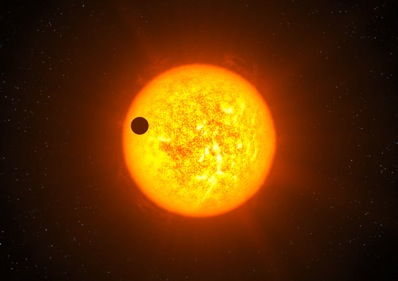
Sizing up a
temperate exoplanet
DR EMILY BALDWIN
ASTRONOMY NOW
Posted: 17 March 2010


Combining observations from the CoRoT satellite and ground-based ESO HARPS instrument, astronomers have a discovered a 'standard' exoplanet that is set to become the Rosetta stone of exoplanet research.
“This is a normal, temperate exoplanet just like dozens we already know, but this is the first whose properties we can study in depth,” says exoplanet hunter Claire Moutou. “It is bound to become a Rosetta stone in exoplanet research.”
 Artist's impression of CoRoT-9b transiting its host star. Image: ESO. Artist's impression of CoRoT-9b transiting its host star. Image: ESO.
Initially discovered by the French space agency operated CoRoT (Convection, Rotation and Transits) space telescope in 2008 using the transit method, whereby a tiny amount of the star's light is blocked out as the planet moves across the disc of the star, confirmation of the object's exoplanet mass and density was provided by the HARPS instrument attached to the 3.6 metre telescope at La Silla in Chile.
Like many other of the 400 exoplanets discovered to date CoRoT-9b has a similar size to Jupiter, but it stands out from the crowd in that its distance from its host star is about ten times larger than that of any planet previously discovered by the transit method, placing it at a similar distance as Mercury is from our Sun.
“Like our own giant planets, Jupiter and Saturn, the planet is mostly made of hydrogen and helium,” says team member Tristan Guillot, “and it may contain up to 20 Earth masses of other elements, including water and rock at high temperatures and pressures.”
The planet passes in front of its host star once every 95 days and takes eight hours to make the transit, offering astronomers the chance to glean bountiful information on the nature of the planet. They team report that CoRoT-9b has an unusually temperate climate, with the temperature of its gassy surface ranging from -20 degrees Celsius to 160 degrees, and with minimal day-to-night variations.
“Our analysis has provided more information on Corot-9b than for other exoplanets of the same type,” says Didier Queloz. “It may open up a new field of research to understand the atmospheres of moderate- and low-temperature planets, and in particular a completely new window in our understanding of low-temperature chemistry.”
The results of the discovery are published in today's edition of the journal Nature.
|



